What can deodorant manufacturers do for you?
deodorant manufacturer Using deodorants with simple operation, specifically designed for odor removal with strong odor, it is currently an effective product in the Chinese market for removing complex chemical waste gases.
Odor pollution belongs to the category of air pollution and has the characteristics of general air pollution. It can also be characterized by olfactory perception and subjective sensation, so it has special characteristics that are different from other air pollution, mainly including the following points.
(1) The reversibility of the impact is usually alleviated by transferring the odor to a fresh air, but the psychological impact lasts longer.
(2) The odor aversion is related to the properties, emission source strength, and concentration of odor substances, but is also greatly affected by environmental and meteorological conditions. For example, in summer, when the atmospheric pressure is low and the wind speed is low, the probability of regional pollution events will be significantly higher than in winter.
(3) The difficulty of prevention and control is directly proportional to the logarithm of the concentration of odor substances, so even if most of the odor components are removed during the odor control process, people's sense of smell will not feel the corresponding degree of control effect, that is, odor prevention and control is more difficult than general air pollution.
(4) A low olfactory threshold is the concentration of small substances that can cause olfaction. The odor threshold value of odorous substances is usually very low, reaching Nl/L level, and even some substances have odor thresholds lower than environmental quality standards or hygiene standards.
(5) The odor of multiple components is often not caused by the odor of a single substance, but exists in the form of a mixture of multiple substances.
This product is an organic interaction of dispersant, flavor masking agent, and modified medicine. Through subtle physical and chemical effects, it can mask various strong and irritating odors such as paint coatings, benzene sulfur compounds, coal tar, rubber, adhesives, etc.

Application field:
Deodorants are suitable for industries such as machinery, electronics, chemicals, pharmaceuticals, light industry, printing, shipbuilding, electrical appliances, etc. to handle concentrated emissions of organic gases or solvents at room or high temperatures.
The types of organic gases and solvents include one or more of the following mixed solvents; Aromatic compounds: benzene, toluene, xylene, styrene, etc;
Ketones: acetone, cyclohexanone, methyl ethyl ketone, etc;
Esters: ethyl acetate, butyl acetate, methyl acetate, banana water, etc; Alcohols: methanol, ethanol, butanol, isopropanol, etc;
Petroleum: volatile gasoline, diesel, etc;
The impact of foul odor on the human body
The impact of foul odor on the human body is mainly divided into three stages: sensory impact, psychological impact, and reversible physiological impact.
Sensory influence refers to the ability of individuals to perceive the presence of foul smelling gases and experience mild discomfort.
Psychological impact refers to the odor, irritability, emotional instability, and lack of concentration caused by the presence of foul smelling gases, and even discomfort that persists even after the odor disappears.
(3) Reversible physiological effects
Mainly reflected in the following aspects:
① The impact on the respiratory system is that foul smelling gases cause people to reflexively screen their main breathing, resulting in an unsmooth respiratory system; ② Impact on the circulatory system, resulting in changes in pulse and blood pressure as breathing changes; ③ The impact on the digestive system is that foul smelling gases can cause loss of appetite, nausea, vomiting, and even indigestion; ④ The impact on the endocrine system, long-term exposure to a foul smelling environment can cause the secretion system of the endocrine system to become disordered, affecting the metabolic activity of the body; ⑤ The impact on the olfactory system can be caused by long-term stimulation of one or several low odor substances, which can lead to loss of smell, fatigue, and other obstacles. These physiological symptoms are mostly relieved with the disappearance of the odor gas.
In general, the impact of foul odor on the human body is limited to the above three stages and does not involve organic lesions caused by high concentrations of harmful gases.
Performance advantages of deodorant manufacturers:
1. This chemical waste gas deodorizer product is specially developed for chemical waste gas; 2. Natural plant liquids are pollution-free and will not produce by-products after reacting with exhaust gas molecules; 3. The economic cost is lower than other processing methods;
5. In line with modern industrial concepts.
The article originates from a deodorant manufacturer http://www.scneng.com.hk
-
06-11
"Environmental Doctor" Du Siyuan: Environmental Protection is a Lifestyle Attitude
There is a Hong Kong compatriot in Jiangmen who often frequents various farms and plantations, walks in mechanical factories, and is seen by others as the nemesis of environmental problems. He conside
-
03-16
Deodorant manufacturer: Deodorants reduce soil pollution
Waste is a chaotic mixture of various components. The accumulation of debris on the surface of soil can cause some chemical reactions, releasing harmful gases, which can lead to soil pollution and eve
-
12-01
Deodorant Manufacturers: Differences between Microbial Deodorants and Traditional Deodorants
The waste that is not needed in our daily life and work is called waste. Due to the large amount of waste discharged and the complex categories, there are great difficulties in reducing waste and deod
-
11-08
Application of Deodorant Manufacturers in Domestic Waste Treatment
Garbage is the waste generated in everyone's daily life and work. Due to its large discharge volume and complex and diverse composition, it poses great difficulties in reducing and deodorizing wa
